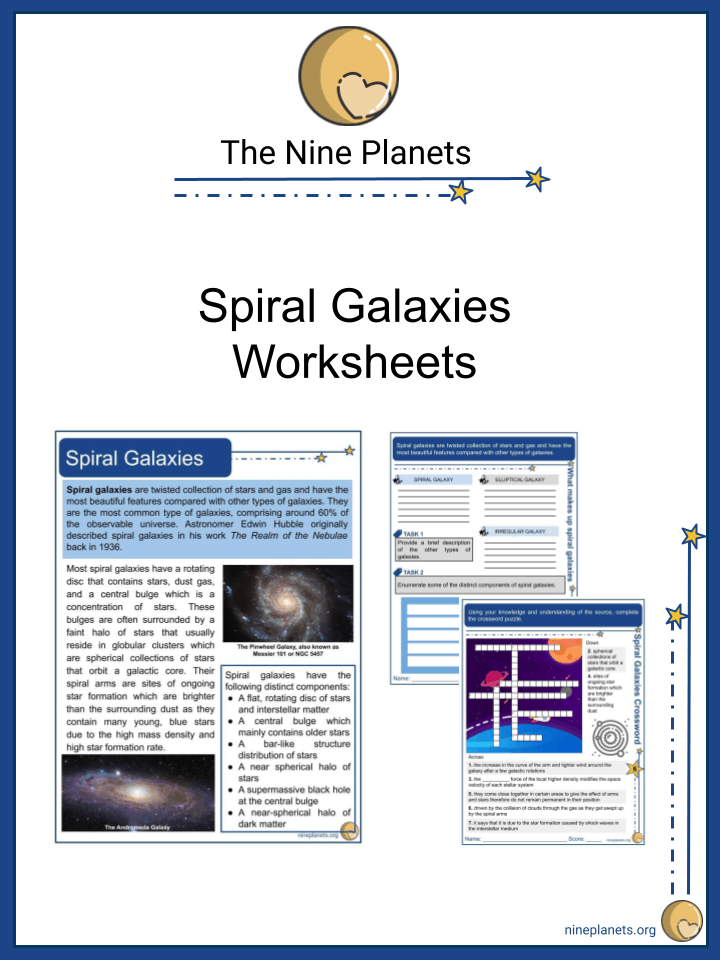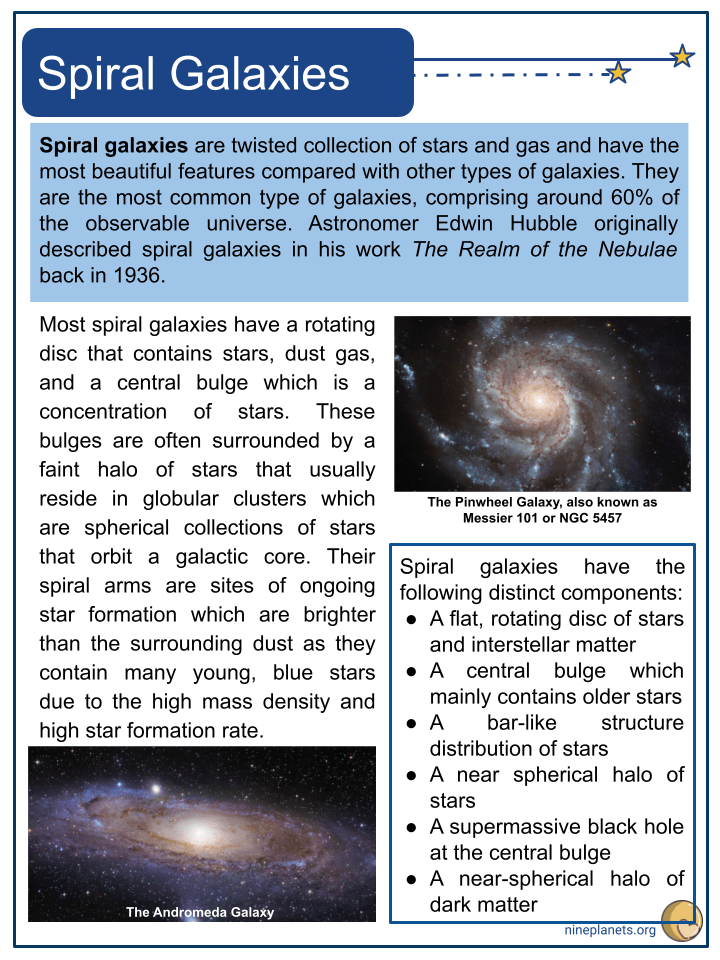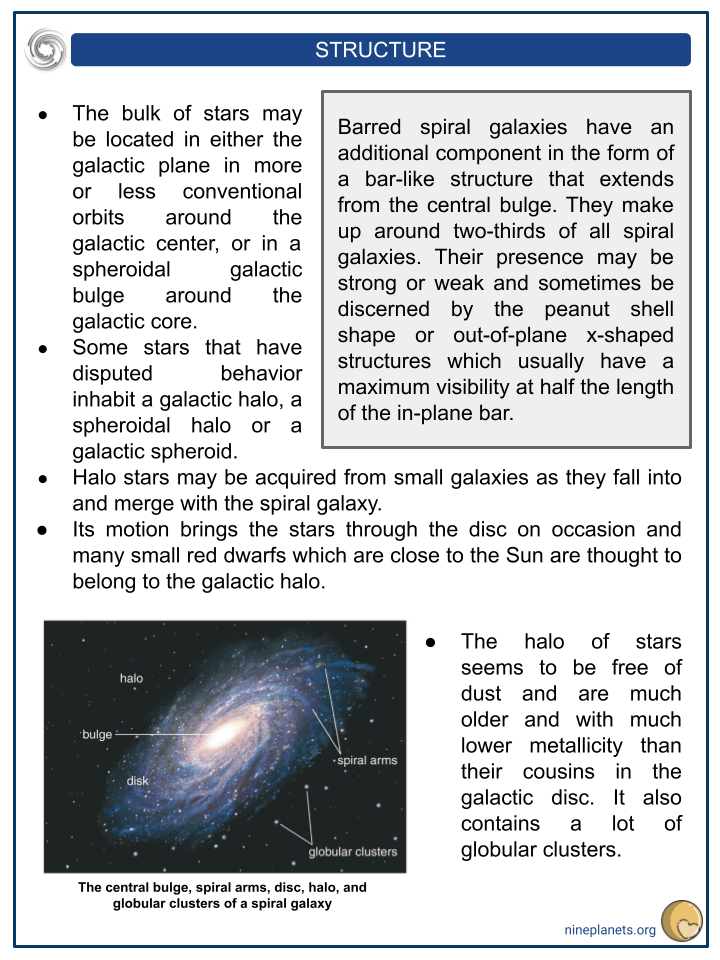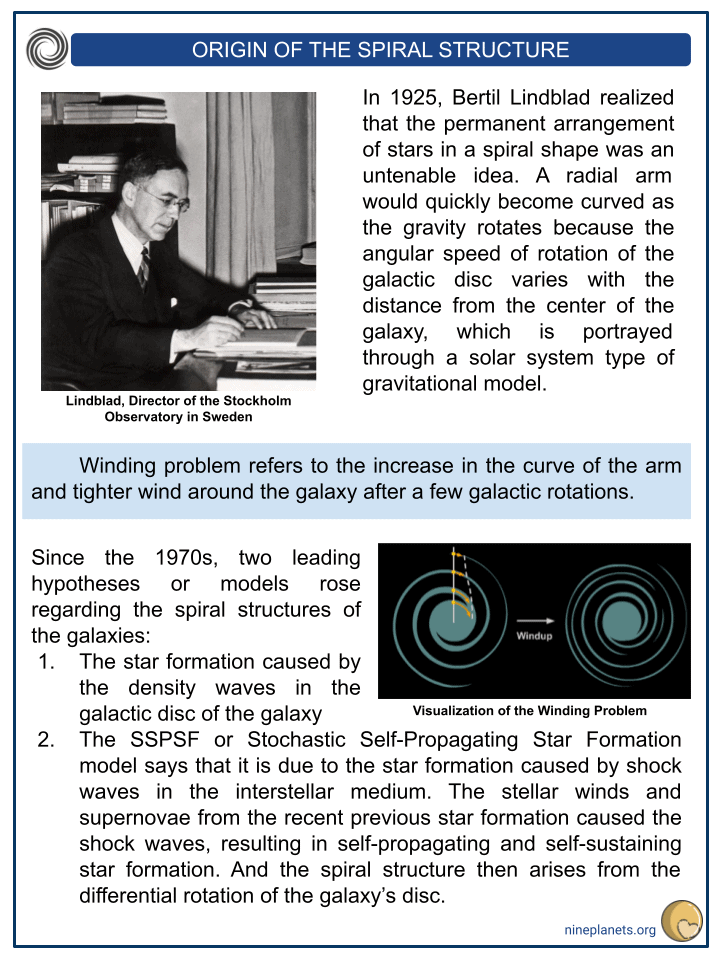Download Spiral Galaxies Worksheets
Click the button below to get instant access to these premium worksheets for use in the classroom or at a home.

This worksheet can be edited by Premium members using the free Google Slides online software. Click the Edit button above to get started.
Download free sample
Not ready to purchase a subscription yet? Click here to download a FREE sample of this worksheet pack.
Resource Examples
Click any of the example images below to view a larger version.




Key Facts & Information
- Spiral galaxies are twisted collection of stars and gas and have the most beautiful features compared with other types of galaxies. They are the most common type of galaxies, comprising around 60% of the observable universe. Astronomer Edwin Hubble originally described spiral galaxies in his work The Realm of the Nebulae back in 1936.
- Most spiral galaxies have a rotating disc that contains stars, dust gas, and a central bulge which is a concentration of stars. These bulges are often surrounded by a faint halo of stars that usually reside in globular clusters which are spherical collections of stars that orbit a galactic core. Their spiral arms are sites of ongoing star formation which are brighter than the surrounding dust as they contain many young, blue stars due to the high mass density and high star formation rate.
- Spiral galaxies have the following distinct components:
- A flat, rotating disc of stars and interstellar matter
- A central bulge which mainly contains older stars
- A bar-like structure distribution of stars
- A near spherical halo of stars
- A supermassive black hole at the central bulge
- A near-spherical halo of dark matter
Structure
- The bulk of stars may be located in either the galactic plane in more or less conventional orbits around the galactic center, or in a spheroidal galactic bulge around the galactic core.
- Some stars that have disputed behavior inhabit a galactic halo, a spheroidal halo or a galactic spheroid.
- Halo stars may be acquired from small galaxies as they fall into and merge with the spiral galaxy.
- Its motion brings the stars through the disc on occasion and many small red dwarfs which are close to the Sun are thought to belong to the galactic halo.
- Barred spiral galaxies have an additional component in the form of a bar-like structure that extends from the central bulge. They make up around two-thirds of all spiral galaxies. Their presence may be strong or weak and sometimes be discerned by the peanut shell shape or out-of-plane x-shaped structures which usually have a maximum visibility at half the length of the in-plane bar.
- The halo of stars seems to be free of dust and are much older and with much lower metallicity than their cousins in the galactic disc. It also contains a lot of globular clusters.
Origin Of The Spiral Structure
- In 1925, Bertil Lindblad realized that the permanent arrangement of stars in a spiral shape was an untenable idea. A radial arm would quickly become curved as the gravity rotates because the angular speed of rotation of the galactic disc varies with the distance from the center of the galaxy, which is portrayed through a solar system type of gravitational model.
- Winding problem refers to the increase in the curve of the arm and tighter wind around the galaxy after a few galactic rotations.
- Since the 1970s, two leading hypotheses or models rose regarding the spiral structures of the galaxies:
- The star formation caused by the density waves in the galactic disc of the galaxy
- The SSPSF or Stochastic Self-Propagating Star Formation model says that it is due to the star formation caused by shock waves in the interstellar medium. The stellar winds and supernovae from the recent previous star formation caused the shock waves, resulting in self-propagating and self-sustaining star formation. And the spiral structure then arises from the differential rotation of the galaxy’s disc.
Density Wave Model
- Bertil Lindblad also proposed that the arms represent regions of enhanced density, which are density waves, that rotate more slowly compared to the galaxy’s stars and gas. A gas gets squeezed and makes new stars, which are some short-lived blue stars at the arms, as it enters density waves.
- In 1964, C.C Lin and Frank Shu devised the first acceptable theory for the spiral structure. It ought to explain the large-scale structure of spirals in terms of a small-amplitude wave propagating with fixed angular velocity which revolves around the galaxy at a speed different from that of the galaxy’s gas and stars.
- Lin and Shu suggested that the spiral arms were manifestations of the spiral density waves, wherein stars were assumed to travel in slightly elliptical orbits, and the orientations of their orbits is correlated.
- The ellipses vary in their orientation in a smooth way with increasing distance from the galactic center.
- Elliptical orbits come close together in certain areas to give the effect of arms and stars therefore do not remain permanent in the position where we can see them.
Young Stars In The Spiral Arms
- Both young stars and more massive and luminous stars make the spiral arms appear to be visually brighter than the rest of the galaxy.
- The demise of the massive stars tends to leave a darker background of fainter stars behind the density waves as they evolve far more quickly.
- The space velocity of each stellar system is modified by the gravitational force of the local higher density as stars move through an arm.
- Also, the newly created stars have no permanent position within the spiral arms, and the average space velocity returns back to normal after the stars depart on the other side of the arm.
- The following hypotheses rose for star formation caused by density waves:
- The local mass density of the gas clouds increases as they move into the density wave.
- Compression wave triggers star formation on the leading edge of the spiral arms as it goes through.
- Clouds collide with one another and drive shock waves through the gas as they get swept up by the spiral arms, causing the gas to collapse and form stars.
Spiral Galaxies Classification
- Spiral Galaxy Type A (Sa) – have a big central bulge and smooth, broad spiral arms
- Spiral Galaxy Type B (Sb) – have a moderately sized bulge and a moderately well-defined spiral arm
- Spiral Galaxy Type C (Sc) – have a small central bulge and narrow, well-defined central arms
- Barred Spiral Galaxy Type A (SBa) – feature tightly bound arms
- Barred Spiral Galaxy Type B (SBb) – feature both tightly and loosely bound arms
- Barred Spiral Galaxy Type C (SBc) – feature loosely bound arms
Did You Know?
- Spiral galaxies constitute around 60% of the galaxies observed by man.
- Spiral galaxies are named after their spiral structures that extend from the center to the galactic disc and are also called disc galaxies.
- Some stars of the Milky Way were observed to be acquired from the Sagittarius Dwarf Spheroidal Galaxy as it is in the process of merging with our galaxy.
- Sagittarius A is believed to be a supermassive black hole of the Milky Way. The bulges of spiral galaxies are usually thought to host a supermassive black hole due to the presence of active nuclei, and dynamical measurements that find large compact central masses in galaxies.
- Charles Francis and Erik Anderson describe how mutual gravity between stars causes orbits to align on logarithmic spirals as the motions of over 20,000 local stars were observed to move along the spiral arms. Applying the theory, collisions between gas clouds produce molecular clouds in which new stars are formed, and the evolution towards the grand-design bisymmetric spirals is explained.
- The Milky Way was once classified as an ordinary spiral galaxy but was reclassified as a barred spiral galaxy. In 2005, the Spitzer Space Telescope confirmed the suspicions regarding the Milky Way as its central bar is larger than previously suspected.
- Spiral galaxies are classified according to the tightness of their spiral, the lumpiness of their arms, and the overall size of their central bulge. These differences are portrayed by the relative amounts of gas and dust contained within the galaxy.
- Around 2% of the mass of Spiral Galaxy Type A is present in the form of gas and dust, and a relatively small portion of these galaxies are involved in star formation.
- Spiral Galaxy Type C contain about 15% gas and dust.
- The nearest spiral galaxy to the Milky Way is the Andromeda galaxy, which is 2.5 million light years away. Astronomers predict that these galaxies will collide in the far future as the Andromeda galaxy is constantly moving closer to us.
- The oldest grand-design spiral galaxy discovered is the BX442. It is currently 11 billion years old. Researchers think that the gravitational influence of a companion dwarf galaxy caused its shape. Based on that assumption, computer models indicate that the spiral structure of BX442 will last about 100 million years.
- NGC 6872 is one of the largest spiral galaxies ever discovered and is 522 light years wide, which is about 5 times the size of Milky Way.
- In 2017, astronomers discovered A1689B11, an 11-billion-year-old spiral galaxy, which is one of the oldest galaxies to be discovered. It might help the scientists to understand how galaxies transform from being highly chaotic, turbulent discs to more organized and thinner discs